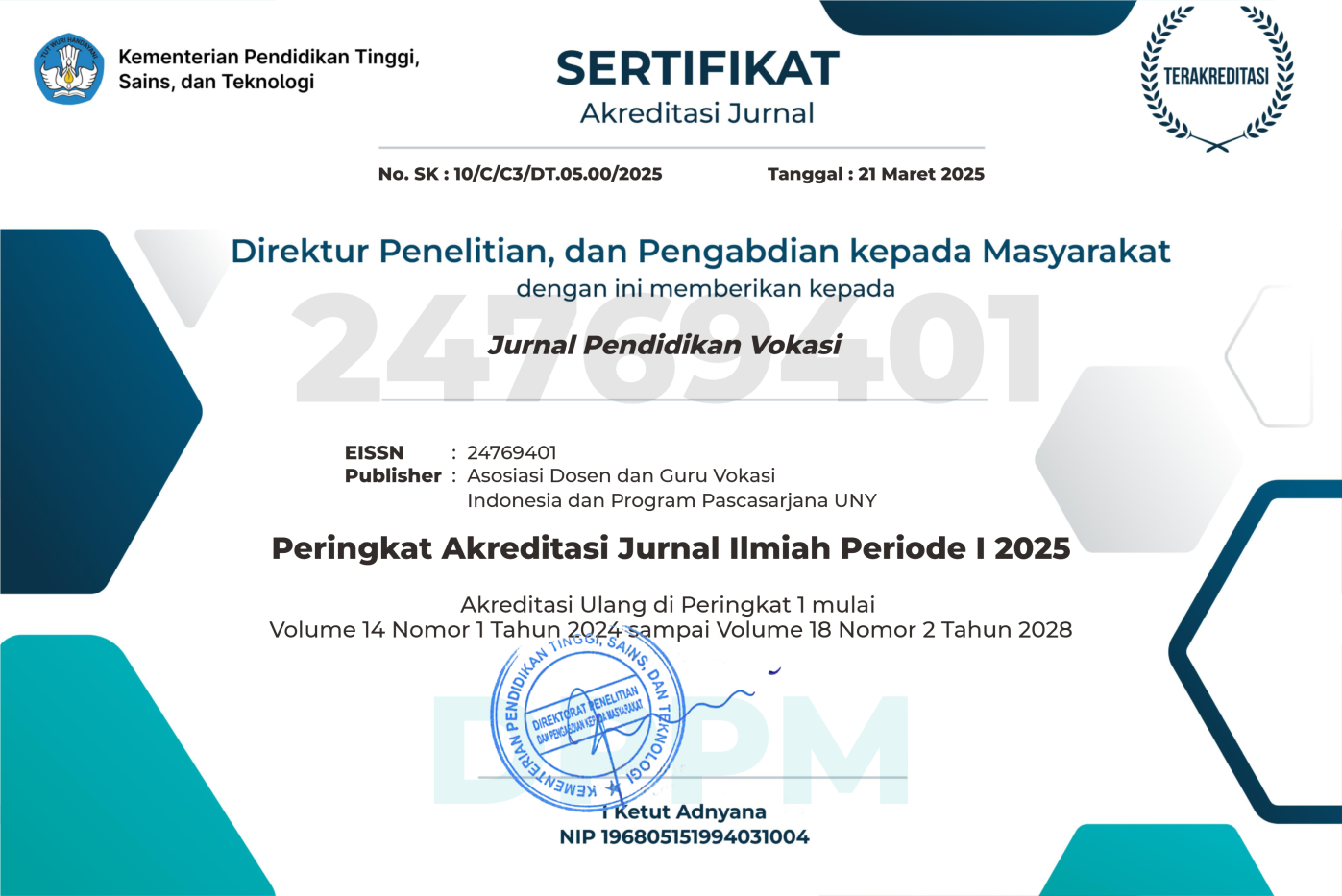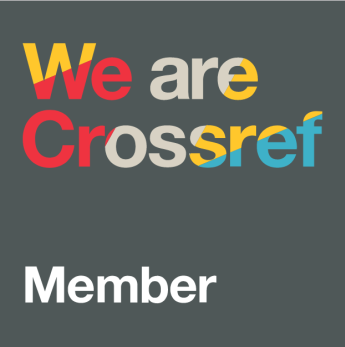Visualizing the stages of the educational research methodology into animation infographics for vocational students
DOI:
https://doi.org/10.21831/jpv.v9i3.22017Keywords:
visualizing, animation infographics, stages of educational research methodology, vocational educationAbstract
Visualizing something abstract into a concrete object can help students improve their mastery of concepts in learning. The purpose of this study is to visualize the stages of the educational research methodology into an animation infographic media. The method used refers to the instructional development model. The target subjects of this study were students of informatics engineering education study program who had taken courses in educational research methodology. In order to get valid, practical, and effective media, several tests were carried out, such as formative evaluation and effectiveness testing with Hake formula. The results show that the dynamic infographic media produced has gone through expert judgment as follows. (1) Testing by content experts score 1 (very high), testing by the learning design experts scored 0.92 (very high), and testing by learning media experts scored 0.90 (very high). (2) The result obtained from the practicality testing is 86.5%, or it is included in the practical category. (3) The testing of the effectiveness of using the Hake formula obtained N-gain results of 0.8, which belongs to the effective category. It shows that animation infographic media produced is valid, practical, and effective to be used in improving the concept mastery of the stages of educational research methodology in informatics engineering education study program.
References
Ackermann, E. (2012). Piaget's constructivism, Papert's constructionism: What's the difference? (pp. 1–11). https://learning.media.mit.edu/content/publications/EA.Piaget _ Papert.pdf
Agustini, K., Santyadiputra, G. S., & Sugihartini, N. (2017). Efektivitas desain instruksional berstrategi blended learning dengan pendekatan konstruktivistik. Seminar Nasional Riset Inovatif 5, 73–79. http://fhis.undiksha.ac.id/wp-content/uploads/2017/12/PROSIDING-SENARI-2017.pdf
Arigia, M. B., Damayanti, T., & Sani, A. (2016). Infografis sebagai media dalam meningkatkan pemahaman dan keterlibatan publik Bank Indonesia. Jurnal Komunikasi, 8(2), 120–133. https://doi.org/10.24912/jk.v8i2.63
Bellei, M., Welch, P., Pryor, S., & Ketheesan, N. (2016). A cost-effective approach to producing animated infographics for immunology teaching " . Journal of Microbiology & Biology Education, 17(3), 477–479. https://doi.org/10.1128/jmbe.v17i3.1146
Central Bureau of Statistics. (2012). Proporsi penduduk berumur 10 tahun ke atas yang membaca selama seminggu terakhir menurut provinsi, jenis bacaan, dan tipe daerah, 2012. Central Bureau of Statistics of Republic of Indonesia. https://www.bps.go.id/statictable/2014/08/20/1521/proporsi-penduduk-berumur-10-tahun-ke-atas-yang-membaca-selama-seminggu-terakhir-menurut-provinsi-jenis-bacaan-dan-tipe-daerah-2012.html
Gredler, M. E. (2009). Learning and instruction: Theory into practice (6th ed.). Pearson.
Hake, R. R. (1999). Analyzing change/gain score. http://www.physics.indiana.edu/nsdi/AnalyzingChange-Gain.pdf
Hanum, N. S. (2013). Keefektifan e-learning sebagai media pembelajaran (studi evaluasi model pembelajaran e-learning SMK Telkom Sandhy Putra Purwokerto). Jurnal Pendidikan Vokasi, 3(1), 90–102. https://doi.org/10.21831/jpv.v3i1.1584
Hassan, H. G. (2016). Designing infographics to support teaching complex science subject: A comparison between static and animated Infographics. Master thesis. Iowa State University, Ames, IA.
Lankow, J., Ritchie, J., & Crook, R. (2014). Infografis: Kedasyatan cara bercerita visual (A. T. K. Widodo (trans.)). Gramedia.
Miftah, M. N., Rizal, E., & Anwar, R. K. (2016). Pola literasi visual infografer dalam pembuatan informasi grafis (infografis). Jurnal Kajian Informasi Dan Perpustakaan, 4(1), 87–94. https://doi.org/10.24198/jkip.v4i1.11635
Mulyate, K., Tanudjaja, B. B., & B., B. S. (2013). Perancangan buku kumpulan infografis resep aneka hidangan pembuka dan penutup ala barat untuk anak-anak. Jurnal DKV Adiwarna, 1(2), 1–11. http://publication.petra.ac.id/index.php/dkv/article/view/1059
Ru, G., & Ming, Z. Y. (2014). Infographics applied in design education. 2014 IEEE Workshop on Advanced Research and Technology in Industry Applications (WARTIA), 984–986. https://doi.org/10.1109/WARTIA.2014.6976439
Rusman, R. (2012). Belajar dan pembelajaran berbasis komputer: Mengembangkan profesionalisme guru abad 21. Alfabeta.
Sindu, I. G. P., & Paramartha, A. A. G. Y. (2018). The effect of problem-based e-learning content on the learning achievement in basic computer system course (DSK) of the student of informatics engineering education department. Jurnal Pendidikan Vokasi, 8(1), 24–32. https://doi.org/10.21831/jpv.v8i1.18098
Siwi, M. K. (2016). Analysis characteristics of learning styles VAK (Visual, Auditory, Kinesthetic) student of banks and financial institutions course. International Conference on Education For Economics, Business, and Finance (ICEEBF) 2016, 437–446.
Suhara, A. M. (2013). Keefektifan model VAK dalam pembelajaran menulis deskriptif. Universitas Pendidikan Indonesia.
Suparman, A. (2012). Desain instruksional modern. Erlangga.
Susetyo, H. R., Bahruddin, M., & Windarti, T. (2015). Efektivitas infografis sebagai pendukung mata pelajaran IPS pada siswa siswi kelas 5 SDN Kepatihan di Kabupaten Bojonegoro. Jurnal Desain Komunikasi Visual, 4(1). https://jurnal.dinamika.ac.id/index.php/ArtNouveau/article/view/762
Tandirerung, V. A., & Hadi, S. (2014). Implementasi e-learning program keahlian TKJ di SMK DIY pasca pembubaran RSBI. Jurnal Pendidikan Vokasi, 4(1), 96–110. https://doi.org/10.21831/jpv.v4i1.2538
Taufik, M. (2012). Infografis sebagai bahasa visual pada surat kabar Tempo. Techno.COM, 11(4), 156–163. https://doi.org/10.33633/tc.v11i4.1010
Zyainuri, Z., & Marpanaji, E. (2013). Penerapan e-learning moodle untuk pembelajran siswa yang melaksanakan prakerin. Jurnal Pendidikan Vokasi, 2(3), 410–426. https://doi.org/10.21831/jpv.v2i3.1046
Downloads
Published
How to Cite
Issue
Section
Citation Check
License
The authors submitting a manuscript to this journal agree that, if accepted for publication, copyright publishing of the submission shall be assigned to Jurnal Pendidikan Vokasi. However, even though the journal asks for a copyright transfer, the authors retain (or are granted back) significant scholarly rights.
The copyright transfer agreement form can be downloaded here: [JPV Copyright Transfer Agreement Form]
The copyright form should be signed originally and sent to the Editorial Office through email to jpvokasi@uny.ac.id
Jurnal Pendidikan Vokasi by http://journal.uny.ac.id/index.php/jpv is licensed under a Creative Commons Attribution-ShareAlike 4.0 International License.












